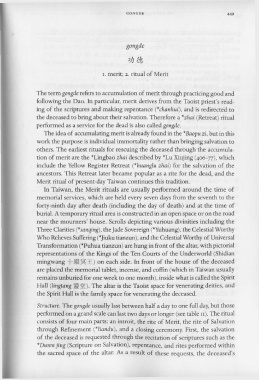Page 489 - The Encyclopedia of Taoism v1_A-L
P. 489
GONGD E 449
gongde
~4.~
1. merit; 2. ritual of Merit
The term gongde refers to accumulation of merit through practicing good and
following the Dao. In particular, merit derives from the Taoist priest's read-
ing of the scriptures and making repentance (*chanhui), and is redirected to
the deceased to bring about their salvation. Therefore a *zhai (Retreat) ritual
performed as a service for the dead is also called gongde.
The idea of accumulating merit is already found in the *Baopu zi, but in this
work the purpose is individual immortality rather than bringing salvation to
others. The earliest rituals for rescuing the deceased through the accumula-
tion of merit are the *Lingbao zhai described by *Lu Xiujing (406-77), which
include the Yellow Register Retreat (*huanglu zhai) for the salvation of the
ancestors. This Retreat later became popular as a rite for the dead, and the
Merit ritual of present-day Taiwan continues this tradition.
In Taiwan, the Merit rituals are usually performed around the time of
memorial services, which are held every seven days from the seventh to the
forty-ninth day after death (including the day of death) and at the time of
burial. A temporary ritual area is constructed in an open space or on the road
near the mourners' house. Scrolls depicting various divinities including the
Three Clarities (*sanqing), the Jade Sovereign (*Yuhuang), the Celestial Worthy
Who Relieves Suffering (*Jiuku tianzun), and the Celestial Worthy of Universal
Transformation (*Puhua tianzun) are hung in front of the altar, with pictorial
representations of the Kings of the Ten Courts of the Underworld (Shidian
mingwang + ~ ~ x ) on each side. In front of the house of the deceased
are placed the memorial tablet, incense, and coffin (which in Taiwan usually
remains unburied for one week to one month), inside what is called the Spirit
Hall (lingtang il1it). The altar is the Taoist space for venerating deities, and
the Spirit Hall is the family space for venerating the deceased.
Structure. The gongde usually last between half a day to one full day, but those
performed on a grand scale can last two days or longer (see table H). The ritual
consists of four main parts: an introit, the rite of Merit, the rite of Salvation
through Refinement (*liandu), and a closing ceremony. First, the salvation
of the deceased is requested through the recitation of scriptures such as the
*Duren jing (Scripture on Salvation), repentance, and rites performed within
the sacred space of the altar. As a result of these requests, the deceased's

